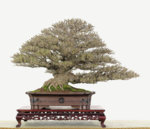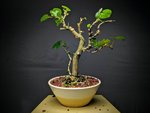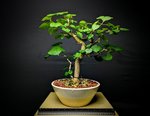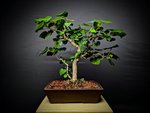You are using an out of date browser. It may not display this or other websites correctly.
You should upgrade or use an alternative browser.
You should upgrade or use an alternative browser.
Sea Hibiscus
- Thread starter SockUnicorn
- Start date
Hyn Patty
Shohin
Interesting. I have never heard of a 'sea hibiscus' before. It's coming along. Oddly enough I have seen some stunning bonsai made from a hibiscus species that really surprised me! Nothing like the tropical hibiscus I grow for their flowers.
MimosaGroveMexia
Sapling
I love my sea hibiscus, but never considered it as bonsai material. The leaves at the end of fall are usually about as big as my hand. Your's looks great, though!
KayaMooney
Mame
This is a very common species used for bonsai throughout Taiwan and other tropical Asian countries. In english its commonly referred to as "sea hibiscus" or "mallow" in the landscape trade. It's also grown here in the Southern islands of Japan and is known as Hamabo (ハマボウ).
Although the leaves are rather large naturally, as you can see from the example below they can be reduced to more than 1/8th of the original size with proper care and technique. Those in the tropics should definitely be paying this species more attention... They are usually shown after defoliation to put focus onto the ramification and structure.
Photos are from http://www.sidiao.com/ and 蘇曉霞 on Facebook.
Although the leaves are rather large naturally, as you can see from the example below they can be reduced to more than 1/8th of the original size with proper care and technique. Those in the tropics should definitely be paying this species more attention... They are usually shown after defoliation to put focus onto the ramification and structure.
Photos are from http://www.sidiao.com/ and 蘇曉霞 on Facebook.
Attachments
JudyB
Queen of the Nuts
They do take a long time to change from soft branching to woody. I've been trying to develop one I got last fall, wiring can get tricky when the branches are so soft for so long. I have not tried to reduce leaves yet, as I'm new to the species. Thanks for these examples.This is a very common species used for bonsai throughout Taiwan and other tropical Asian countries. In english its commonly referred to as "sea hibiscus" or "mallow" in the landscape trade. It's also grown here in the Southern islands of Japan and is known as Hamabo (ハマボウ).
Although the leaves are rather large naturally, as you can see from the example below they can be reduced to more than 1/8th of the original size with proper care and technique. Those in the tropics should definitely be paying this species more attention... They are usually shown after defoliation to put focus onto the ramification and structure.
Photos are from http://www.sidiao.com/ and 蘇曉霞 on Facebook.
SockUnicorn
Shohin
Love the discussion going on in here!
MimosaGroveMexia
Sapling
Very cool! Thank you for sharingThis is a very common species used for bonsai throughout Taiwan and other tropical Asian countries. In english its commonly referred to as "sea hibiscus" or "mallow" in the landscape trade. It's also grown here in the Southern islands of Japan and is known as Hamabo (ハマボウ).
Although the leaves are rather large naturally, as you can see from the example below they can be reduced to more than 1/8th of the original size with proper care and technique. Those in the tropics should definitely be paying this species more attention... They are usually shown after defoliation to put focus onto the ramification and structure.
Photos are from http://www.sidiao.com/ and 蘇曉霞 on Facebook.
I think I'll try to strike some cuttings or air layer a branch this spring to work on.
They seem to be fairly fast growers. My greenhouse is 14 or 16 foot tall and I have to cut the sea hibiscus way back every autumn in order to get it through the door and keep it from hitting the ceiling.
Does anyone know if they ever bloom as bonsai? I know the flowers would be large, but mine has never bloomed- which my friend/the nursery owner said was due to having to cut it back to bring it inside in our zone (8b).
SockUnicorn
Shohin
SockUnicorn
Shohin
I have had a couple of hibiscus that I have been trying to train. Being a beginner, I am sure I am doing it wrong. They tend to push flowers when you leave them alone. I am training one as an informal upright and trying to do another as a cascade. Everything wants to grow straight up, so not always easy to have a good vision. Both flower every year, though not nearly as prolific as if you let it bush out in direct sun. I get aphids like crazy when I bring em in too.
SockUnicorn
Shohin
SockUnicorn
Shohin
SockUnicorn
Shohin
SockUnicorn
Shohin
Similar threads
- Replies
- 14
- Views
- 779









